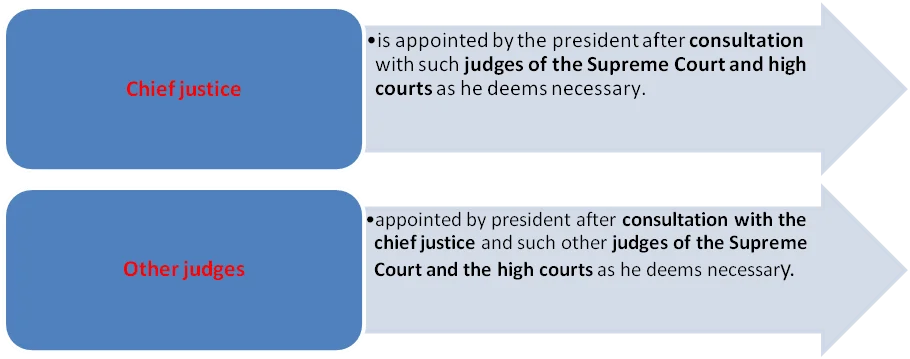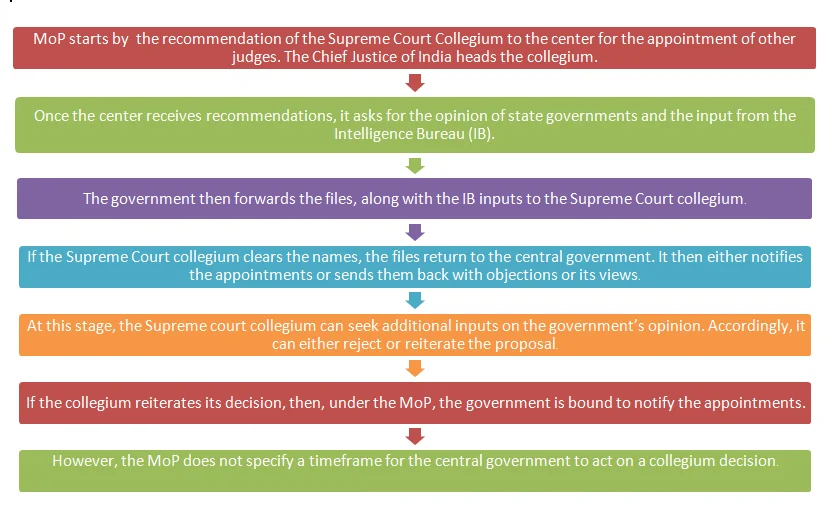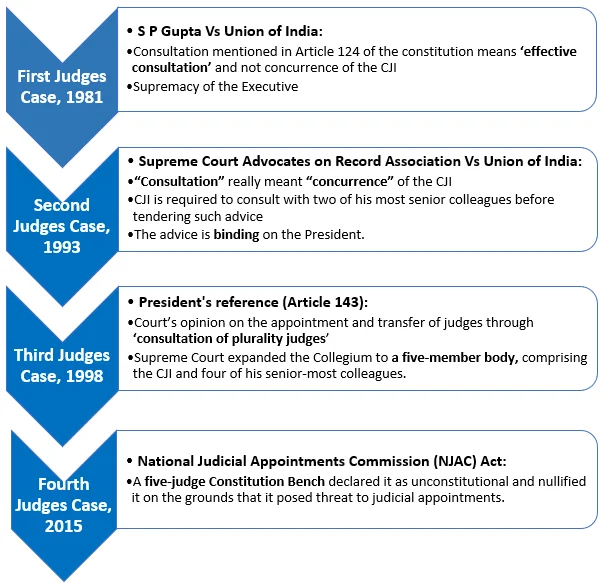The Supreme Court of India, established in 1950, serves as the highest judicial authority in the country. Its formation followed a rich historical evolution, beginning with the Regulating Act of 1773. This article explores the structure and functioning of the Supreme Court, including the appointment of judges and the significance of the collegium system in maintaining judicial integrity.
The Supreme Court of India
Historical Background
- Regulating Act of 1773: The promulgation of the Regulating Act of 1773 by the King of England paved the way for establishment of the Supreme Court of Judicature at Calcutta in 1774.
- Establishment of Supreme Courts in Madras and Bombay: The Supreme Courts at Madras (1800) and Bombay (1823) were established by King George – III.
- India High Courts Act, 1861: The India High Courts Act, 1861 was enacted to create High Courts for various provinces and abolished Supreme Courts at Calcutta, Madras and Bombay and also the Sadar Adalats in Presidency towns.
- Role of High Courts: These High Courts had the distinction of being the highest Courts for all cases till the creation of the Federal Court of India under the Government of India Act, 1935.
- Federal Court of India: The Federal Court had jurisdiction to solve disputes between provinces and federal states and hear appeals against judgements from High Courts.
- First Sitting of the Supreme Court: The Supreme Court of India held its first sitting on 28 January 1950.
Enroll now for UPSC Online Course
Indian Judicial System

- Single System of Courts: The Constitution of India envisages a single system of courts that enforces both Central laws as well as state laws.
- Integrated Judicial Structure: It is an integrated judicial system with the Supreme Court at the top and the High Courts below it.
- Hierarchy of Subordinate Courts: Under a High Court, there is a hierarchy of subordinate courts, i.e. district courts and other lower courts.
-
- Constitutional Provisions: In Part V of the Constitution, Articles 124 to 147 deals with the organisation, independence, jurisdiction, powers, procedures for the Supreme Court.
- The Parliament is also authorised to regulate them.
| There is a double system of courts in the USA i.e. one for the centre and the other for the states.
The federal laws are enforced by the federal judiciary while the state laws are enforced by the state judiciary. |
Composition and Appointment of Judges
Composition Judges
- Constitution Supreme
- al Provision: Article 124 (1): There shall be a Supreme Court of India constituting of a Chief Justice of India and, until Parliament by law prescribes a larger number, of not more than seven other Judges
- Current Strength: Currently, the Supreme Court consists of thirty-four judges (one Chief Justice and thirty-three other judges), while earlier in 2019 it was 31 judges.
- Historical Context: Originally, the strength of the Supreme Court was fixed at eight.
- The Parliament increased this number of other judges progressively to ten in 1956, to thirteen in 1960, to seventeen in 1977, to twenty-five in 1986, to thirty in 2008 and thirty-three in 2019.

Appointment of Judges
- Constitutional Provision: Article 124 (2): Every Judge of the Supreme Court shall be appointed by the President by warrant under his hand and seal after consultation with such of the Judges of the Supreme Court and of the High Courts in the States as the President may deem necessary for the purpose and shall hold office until he attains the age of sixty five years.
- Determination of Age: The age of a Judge of the Supreme Court shall be determined by such authority and in such manner as Parliament may by law provide.

Evolution of Collegium System
Present Scenario
- Key Steps in the Appointment of Supreme Court Judges: The process for appointing judges to the Supreme Court of India involves the following key steps:
- Initiation of the Process:
-
-
-
- Vacancies: When a position of a judge in the Supreme Court is about to become vacant or is vacant, the Chief Justice of India (CJI) initiates the process.
-
-
- Recommendations by the Collegium:
-
-
-
- Collegium System: Recommendations for judicial appointments are made by the Collegium, which comprises the CJI and a group of four senior most judges of the Supreme Court.
- Consultation: The Collegium consults among its members and considers the names of judges from high courts or lawyers who are eligible for elevation to the Supreme Court.
-
-
- Opinion of the Chief Justice of India:
- The CJI’s opinion holds significant weight in the Collegium’s decision-making process.
- Review by the Collegium:
- The Collegium reviews the suitability and merit of the candidates and may reconsider the names proposed for appointment.
- Consultation with the Central Government:
-
-
- Once the Collegium finalises its recommendations, it sends the names to the central government for consultation.
- The government can express any concerns or seek clarification on the recommended names, but it is not binding on the Collegium.
-
-
- President’s Approval:
- After considering the recommendations and any inputs from the government, the President Of India gives the final approval for the appointments.
- Issuance of Warrants:
- Upon receiving the President’s approval, the Chief Justice of India issues warrants of appointment.
- Swearing-In Ceremony:
- The newly appointed judge is then sworn in and officially assumes office.
Critique of the Collegium System in Judicial Appointments
- It’s important to note that the process of judicial appointments has evolved over time, and the Collegium system has been a subject of debate and discussions.
- The Collegium system has been criticised for lacking transparency and accountability, leading to various proposals for reforms in the appointment process.

Qualifications, Oath and Salaries
Qualifications of Judges
- Constitutional Provision: Article 124(3): A person shall not be qualified for appointment as a Judge of the Supreme Court unless he is a citizen of India and-
- (a) has been for at least five years a Judge of a High Court or of two or more such Courts in succession; or
- (b) has been for at least ten years an advocate of a High Court or of two or more such Courts in succession; or
- (c) is, in the opinion of the President, a distinguished jurist.
- Minimum Age for Appointment: The Constitution has not prescribed a minimum age for appointment as a judge of the Supreme Court.
Oath or Affirmation
- Oath of Office for a Supreme Court Judge: As per Third Schedule of the Constitution a person appointed as a judge of the Supreme Court has to take an oath or affirmation before the President, or some person appointed by him .
- Content of the Oath: In his oath, a judge of the Supreme Court swears:
- To bear true faith and allegiance to the Constitution of India;
- To uphold the sovereignty and integrity of India;
- To duly and faithfully and to the best of his ability, knowledge and judgement perform the duties of the Office without fear or favour, affection or ill-will and
- To uphold the Constitution and the laws.
Salaries and Allowances
- Constitutional Provision: Article 125: There shall be paid to the Judges of the Supreme Court such salaries as may be determined by Parliament by law and, until provision in that behalf is so made, such salaries as are specified in the Second Schedule.
- Determination by Parliament:
-
- Entitlement to Privileges and Allowances: Every judge shall be entitled to privileges and allowances as determined by law made by Parliament.
- Rights Regarding Leave of Absence and Pension: Judges are entitled to rights concerning leave of absence and pension, as specified by or under parliamentary law.
- Interim Provisions: Until Parliament determines otherwise, judges shall receive the privileges, allowances, and rights specified in the Second Schedule of the Constitution.
- Charged Expenditure: This expenditure forms part of charged expenditure on Budget i.e. not votable by the Parliament.
- Relevant Legislation: Parliament in this regard made a law called, The Supreme Court judges (Salaries, and Conditions of Services) Act, 1958.
- Protection Against Disadvantage: They cannot be varied to their disadvantage after their appointment except during a financial emergency.
- Additional Allowances and Facilities: They are also paid a sumptuary allowance and provided with free accommodation and other facilities.
- Pension for Retired Judges: The retired Chief Justice and judges are entitled to 50 per cent of their last drawn salary as monthly pension.
- They are also paid a sumptuary allowance and provided with free accommodation and other facilities.
- The retired Chief Justice and judges are entitled to 50 per cent of their last drawn salary as monthly pension.
Enroll now for UPSC Online Course
| Must Read | |
| Current Affairs | Editorial Analysis |
| Upsc Notes | Upsc Blogs |
| NCERT Notes | Free Main Answer Writing |
Conclusion
In conclusion, the Supreme Court plays a vital role in upholding justice in India through its structured framework and appointment process.
- Understanding its historical context, composition, and functions helps appreciate the challenges it faces today.
- As the guardian of the Constitution, the Supreme Court remains essential in preserving the rule of law and protecting citizens’ rights.
Sign up for the PWOnlyIAS Online Course by Physics Wallah and start your journey to IAS success today!
| Related Articles | |
| Who is the First Woman Chief Justice of India? | High Courts in India |
| Supreme Court | GOVERNMENT OF INDIA ACT, 1935 |

 GS Foundation
GS Foundation Optional Course
Optional Course Combo Courses
Combo Courses Degree Program
Degree Program













